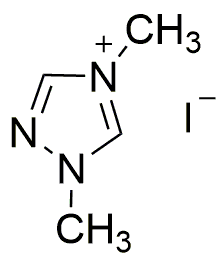1,4-Dimethyl-1,2,4-triazolium iodide is widely utilized in research focused on:
- Agricultural Chemistry: It serves as a potent fungicide, effectively controlling fungal diseases in crops, thereby enhancing agricultural productivity.
- Pharmaceutical Development: This compound is explored for its potential as an antimicrobial agent, providing researchers with a new avenue for developing effective treatments against resistant pathogens.
- Material Science: It is used in the synthesis of advanced materials, particularly in the development of ionic liquids, which have applications in energy storage and catalysis.
- Electrochemistry: The compound is utilized in the formulation of electrolytes for batteries, improving performance and efficiency in energy storage systems.
- Organic Synthesis: It acts as a useful reagent in various organic reactions, offering chemists a versatile tool for synthesizing complex molecules with high yields.
General Information
Properties
Safety and Regulations
Applications
1,4-Dimethyl-1,2,4-triazolium iodide is widely utilized in research focused on:
- Agricultural Chemistry: It serves as a potent fungicide, effectively controlling fungal diseases in crops, thereby enhancing agricultural productivity.
- Pharmaceutical Development: This compound is explored for its potential as an antimicrobial agent, providing researchers with a new avenue for developing effective treatments against resistant pathogens.
- Material Science: It is used in the synthesis of advanced materials, particularly in the development of ionic liquids, which have applications in energy storage and catalysis.
- Electrochemistry: The compound is utilized in the formulation of electrolytes for batteries, improving performance and efficiency in energy storage systems.
- Organic Synthesis: It acts as a useful reagent in various organic reactions, offering chemists a versatile tool for synthesizing complex molecules with high yields.
Documents
Safety Data Sheets (SDS)
The SDS provides comprehensive safety information on handling, storage, and disposal of the product.
Product Specification (PS)
The PS provides a comprehensive breakdown of the product’s properties, including chemical composition, physical state, purity, and storage requirements. It also details acceptable quality ranges and the product's intended applications.
Certificates of Analysis (COA)
Search for Certificates of Analysis (COA) by entering the products Lot Number. Lot and Batch Numbers can be found on a product’s label following the words ‘Lot’ or ‘Batch’.
Numéro de catalogue
Numéro de lot/série
Certificates Of Origin (COO)
This COO confirms the country where the product was manufactured, and also details the materials and components used in it and whether it is derived from natural, synthetic, or other specific sources. This certificate may be required for customs, trade, and regulatory compliance.
Numéro de catalogue
Numéro de lot/série
Safety Data Sheets (SDS)
The SDS provides comprehensive safety information on handling, storage, and disposal of the product.
DownloadProduct Specification (PS)
The PS provides a comprehensive breakdown of the product’s properties, including chemical composition, physical state, purity, and storage requirements. It also details acceptable quality ranges and the product's intended applications.
DownloadCertificates of Analysis (COA)
Search for Certificates of Analysis (COA) by entering the products Lot Number. Lot and Batch Numbers can be found on a product’s label following the words ‘Lot’ or ‘Batch’.
Numéro de catalogue
Numéro de lot/série
Certificates Of Origin (COO)
This COO confirms the country where the product was manufactured, and also details the materials and components used in it and whether it is derived from natural, synthetic, or other specific sources. This certificate may be required for customs, trade, and regulatory compliance.


